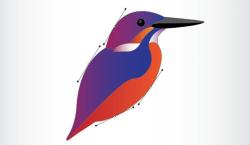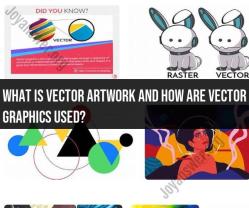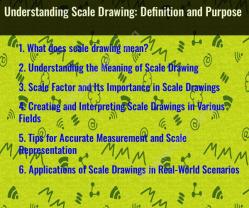How to submit and sell your vector art?
Submitting and selling vector art can be a rewarding endeavor. Here are some strategies to help you successfully submit and sell your vector art:
1. Create High-Quality Art:
- Ensure your vector art is of high quality. Pay attention to details, use clean lines, and optimize your files for scalability.
2. Choose the Right Platforms:
- Stock Agencies: Submit your vector art to popular stock agencies like Adobe Stock, Shutterstock, iStock, or other platforms that specialize in selling digital assets.
- Art Marketplaces: Consider platforms like Etsy or Creative Market for selling directly to customers.
3. Build a Strong Portfolio:
- Create a diverse portfolio showcasing a variety of styles and themes to attract a broader audience.
4. Optimize Metadata and Descriptions:
- Use relevant keywords, tags, and detailed descriptions to make your vector art easily discoverable by potential buyers.
5. Follow Submission Guidelines:
- Adhere to the submission guidelines of the platforms you choose. Different platforms may have specific requirements regarding file formats, dimensions, and other criteria.
6. Promote Your Art:
- Leverage social media platforms, a personal website, or a blog to showcase your vector art. Share work-in-progress shots, behind-the-scenes content, and stories about your creative process.
7. Engage with the Community:
- Participate in online communities related to vector art and design. Networking can lead to collaborations, exposure, and valuable insights.
8. Offer Freebies and Discounts:
- Periodically offer free vector art or discounts to attract attention and build a loyal customer base.
9. Stay Consistent:
- Regularly update your portfolio with new and fresh vector art. Consistency can keep your audience engaged and attract new customers.
10. Understand Licensing Options:
- Familiarize yourself with different licensing models (royalty-free, rights-managed, etc.) and choose the one that aligns with your goals and preferences.
11. Price Your Art Strategically:
- Research the pricing strategies of successful artists in your niche. Consider factors like your skill level, the complexity of the art, and market demand when setting prices.
12. Provide Excellent Customer Service:
- Respond promptly to customer inquiries and address any issues professionally. Positive customer experiences can lead to repeat business and positive reviews.
13. Protect Your Work:
- Consider watermarking your preview images, and be aware of the licensing terms on each platform to protect your vector art from unauthorized use.
14. Seek Feedback:
- Be open to feedback from customers and the creative community. Continuous improvement based on constructive criticism can enhance the quality of your work.
By combining these strategies, you can increase your chances of successfully submitting and selling your vector art. Remember that building a sustainable income from selling digital art may take time, so stay persistent and continually refine your approach based on your experiences.
How to submit and sell your own vector art?
Submitting and selling your own vector art can be a great way to turn your creative passion into profit. Here are the basic steps involved:
1. Choose your platform:
There are various platforms where you can submit and sell vector art, each with its own requirements and benefits. Some popular options include:
- Stock photo websites: Shutterstock, Adobe Stock, iStock, Getty Images, VectorStock, etc. These platforms offer a large audience and potential for passive income, but they typically have high competition and low royalty rates.
- Creative marketplaces: Creative Market, Envato Elements, Design Bundles, etc. These platforms cater to a more design-focused audience and offer more flexibility in pricing and licensing.
- Print-on-demand websites: Redbubble, Society6, ArtStation, etc. These platforms allow you to sell your art on various products like t-shirts, mugs, phone cases, etc. This requires less upfront investment but requires marketing to drive sales.
- Your own website: This offers the most control over your brand and pricing, but requires more effort to build and maintain your online presence.
2. Prepare your artwork:
Ensure your vector art is of high quality and meets the platform's technical requirements. This often includes minimum file size, resolution, and format. Check the platform's guidelines for specific details.
3. Optimize your listings:
- Choose appropriate keywords and tags: Research popular search terms related to your artwork to increase visibility.
- Write compelling descriptions: Clearly explain what your artwork is and how it can be used.
- Set competitive prices: Consider the platform's commission fees and your desired profit margin.
- Use attractive thumbnails: Showcase your artwork in a visually appealing way.
4. Promote your artwork:
Don't rely solely on the platform's organic traffic. Utilize social media, email marketing, and other channels to promote your artwork and reach your target audience.
5. Be patient and persistent:
Building a successful online business takes time and effort. Don't get discouraged if you don't see results immediately. Keep creating new artwork, refining your marketing strategy, and learning from your experience.
Here are some additional resources that you may find helpful:
- Adobe Stock Contributor Tutorial: https://helpx.adobe.com/stock/how-to/submit-sell-vector-art.html
- CorelDRAW Guide to Selling Vector Art: https://www.coreldraw.com/en/learn/guide-to-vector-design/how-to-sell-vector-art/
- Freepik Contributor Tutorial: https://m.youtube.com/watch?v=WbtrHc0wdfo
Remember, the key to success is to create high-quality artwork, choose the right platform, and actively promote your work. With dedication and effort, you can build a thriving business selling your vector art online.











